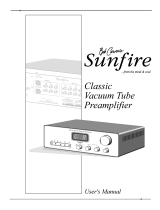
4
Important Information
WARNING: The McIntosh C500 is a two chassis design,
with separate Preamplifier and Controller
chassis. There are custom interconnecting
cables and custom chassis sockets used to
connect the two chassis together.
Use ONLY the custom interconnect cables
supplied with the C500 to connect the chassis
together.
DO NOT connect the C500 Left and Right 25-
Pin Chassis Sockets to any other component.
Failure to observe the above warnings will
result in damage to the components connected.
1. The C500 System consists of two separate chassis, one
Controller and one Preamplifier. The C500 Controller
Chassis will be referred to as the C500C throughout this
Owner’s Manual. In a similar manner, the C500
Preamplifier (Solid State) Chassis will be referred to as the
C500P and the C500 Tube Preamplifier Chassis will be
referred to as the C500T throughout this Owner’s Manual.
2. For additional information on Audio Connections, refer to
the Owner’s Manual(s) for the component(s).
3. Connecting Cables and Connectors are available from the
McIntosh Parts Department:
Data, Power Control and Trigger Cable Part No.
170-202
Six foot, shielded 2 conductor, with 1/8 inch stereo mini
phone plug on each end.
Controller to Preamplifier Cable Part No. 171-872
Three foot, shielded 23 conductor, male-to-female
custom cable, two required between Controller and
Preamplifier. Do not use any other cable when
connecting the C500 Controller to the C500
Preamplifier or C500 Tube Preamplifier. This cable is
for use only with the C500 Controller and Preamplifier.
4. The Main AC Power Cable going to the C500C and any
other McIntosh Component(s) should not be connected to
an AC Power Outlet until all the system components are
connected together. When the C500C and other McIntosh
Components are in their Standby Power Off Mode, the
Microprocessor’s Circuitry inside each component is active
and communication is occurring between them. Failure to
do so could result in malfunctioning of some or all of the
system’s normal operations.
5. Up to two sensors can be wired in parallel for Remote
Control of the C500 from other rooms.
6. Balanced and Unbalanced Inputs and Outputs can be
mixed. For example, you may connect signal sources to
Unbalanced Inputs and send signals from the Balanced
Outputs. You can also use Balanced and Unbalanced
outputs simultaneously, connected to different power
amplifiers.
7. Sound Intensity is measured in units called Decibels and
“dB” is the abbreviation.
The C500 Preamplifier with a Controller is one of the finest
audio preamplifiers McIntosh has ever created. No design
compromises were allowed in the quest for a preamplifier,
both Solid State and Tube with absolute accuracy, total
sonic purity and virtual elimination of distortion and audible
noise. For those who have been searching for the “Best in
Preamplifiers”, your wait is over.
Introduction
XLR Connectors
Below is the Pin configuration for the XLR Balanced Input
and Output Connectors on the C500 Preamplifier. Refer to
the diagram for connection:
PIN 1: Shield/Ground
PIN 2: + Signal
PIN 3: - Signal
Main Power Control Connectors
The C500’s Power Control Outputs provide a +5 volt sig-
nal. An additional connection is for
controlling the illumination of a Power
Amplifier Output Meter. Use a 1/8
inch stereo mini phone plug to connect
to the Power Control Input on other
McIntosh Components.
Trigger Control Connectors
The C500’s Trigger Control Outputs provide either a +5
volt (default) or +12 volt signal (refer to
page 18). Use a 1/8 inch stereo mini
phone plug to connect to the Power
Control Input on McIntosh and/or non-
McIntosh components.
Data and IR Port Connectors
The C500’s Data Port Output provides Remote Control Sig-
nals. Use a 1/8 inch stereo mini
phone plug to connect to the Data
Port Inputs on McIntosh Source
Units.
Pin 1
Pin 2
Pin 3
Connector Information
Data Signal
N/C
Data Ground
Power
Control
Meter
Illumination
Control
Ground
Trigger
Control
N/C
Ground
8. If the C500P and/or C500T Preamplifiers 23-conductor
custom interconnect cable(s) becomes temporarily
disconnected from the C500C when it is On or in Stand-by
Mode, a cable error message will appear on the C500C.
Remove the AC Power Cord from the C500C, connect the
disconnected 23-conductor custom interconnect cable(s)
and then reconnect the AC Power Cord. The C500 System
will automatically reset itself to the previous configuration.
























